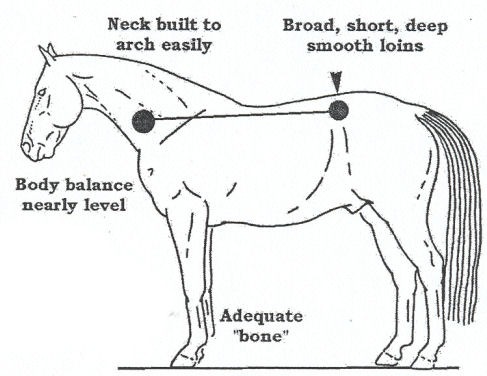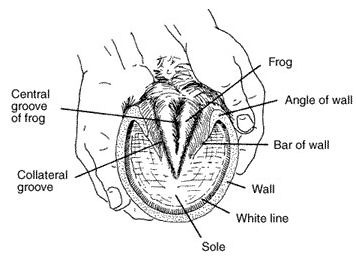Horsemanship Level 4: Conformation & Unsoundness pt II
Previously we looked at types of horses, their differing builds and their abilities. This week we'll examine general conformation, and what to look for when assessing any horse.
Over centuries of domestication, selective breeding has created the variety of breeds and types we looked at in the last post. However, the modern horse still looks much more similar to the primitive horse, like the Przewalski's Horse pictured here, than a Chihuahua or a Great Dane does to a wolf. Despite human fancies, the horse has been a working animal, and function has had to prevail over fashion.
This has been a blessing for the horse, who is more fortunate than our canine and feline pets, many of whom have been overbred to the point of infirmity. This is not to say the horse has been immune to dangerous breeding: the tiny feet and overmuscled rump of some Quarter Horses, the 'teacup muzzle' and bulging jibbah (forehead) of some Arabians, and the Miniature Horses who suffer limb abnormalities and reproductive problems that come with breeding for small size are all examples of human folly decreasing the horse's usefulness and health.
However, the more you learn about conformation, the more you train your eye to see the beauty of function.
Overall Impression
As you develop your eye you will learn to make a quick first judgement of a well-proportioned horse. When looking from the side, he should 'fit in a box'. That is, the body, excluding head and neck, should be roughly as long as the horse is tall. In addition the body parts should appear balanced in proportion to each other, and the horse's expression should be alert and intelligent.
The Head
Large, clear, eyes set well apart give a broad range of vision. Width across the jaw allows good wind, as do large nostrils. If the head and neck meet at too acute an angle the windpipe may be compressed; too large an angle may mean the horse will have difficulty flexing at the poll.
The Neck
The neck should have a slight arch from poll to withers, be roughly half the length of the body, and have a medium 'set' or placement relative to the shoulder. It should blend smoothly with the withers.
The Shoulders
The shoulders should slope well from withers to point of shoulder to allow a good stride length. Short, upright shoulders will cause a horse to have a shorter, choppier gait. The withers should be of medium height: too low or too high can make saddle fitting difficult.
The Topline
The withers, back, loin and croup form the topline. They should blend smoothly together. A short back, broad and smooth across the loins, should connect to a well-rounded croup, and is desirable for a stronger animal.
The Chest, Body & Underline
A wide chest, large heart-girth circumference, and well 'sprung' (arched) ribs indicates greater lung and heart capacity for stamina. The underline should be nearly level -- neither pot-bellied or herring-gutted (wasp-waisted), indicating proper pelvic alignment and good musculature.
The Forelegs
The forelegs should match one another in all angles and proportions from shoulder to hoof. Mismatched legs are a red flag, indicating either past injuries or congenital unsoundness now or down the road. The knees should be broad and flat, the legs straight from shoulder to pastern, with plenty of 'bone' circumference below the cannon. Shorter cannons in relation to forearm give a smoother, longer stride.
The Hindquarters
The hind end is the horse's engine, and should be strong and well-made, with a good length of well-developed muscle from stifle to hock. The hocks are the hardest worked joints in the body and they should be appear clean and well defined. It is normal for the hind legs to appear slightly turned out, but the angle should be consistent from stifle to hoof. Like the forelegs, the cannons should be short and strong.
This is a very quick overview of conformation. For more detail read your Manual of Horsemanship, the USPC Guide to Conformation Movement and Soundness, or Dr Deb Bennett's excellent Principles of Conformation Analysis. For your exam, be prepared to point out three or four good points of your horse, and three or four less than desirable aspects, as well as giving a general view of your horse's capabilities based on her conformation. It will help to learn the definitions of the following terms and what they look like:
- Roman, straight and dished profiles, parrot-mouth, monkey mouth
- Bull neck, ewe neck, cock-throttled, low & high-set
- Loaded withers, mutton withers, straight shoulder
- Hollow back, roach back, herring gut, short & rough-coupled, goose rump
- Turned-out, turned-in, back at the knee, over at the knee, open knees, tied in, bowed knees, knock knees
- Bowed hocks, sickle hocks, cow hocks, post-legged
- Base narrow, base wide, camped out in front / behind, standing under
- Steep pastern, long pastern, coon-footed, buttress footed
Current Classes
Beginner Riding & Horsemanship
This six-week series will teach you to groom, tack up, and handle your horses as well as getting you started in the saddle. By the end of six weeks you should be ready to test for Horsemanship Level 1, and a second run through the course will get most people to Riding Level 1. Choose between Saturday or Sunday classes — or take both to get you to your goal twice as fast!
Sundays 13 Mar – 17 Apr, 10am – noon
Saturdays 2 Apr – 7 May, 4pm – 6pm
cost: $300 for 6 classes
Riding & Horsemanship Level 2
The Level 2 course covers the same topic areas as Level 1 but in greater depth. You will progress through the Horsemanship Level 2 curriculum while continuing to work on achieving your Riding Levels 1 or 2. If you are unsure whether you should sign up for Level 2 or Beginner, just pick the class which has space. The courses run simultaneously and riders are informally assessed during the first class, with placements shuffled to make sure everyone is riding with a group of the appropriate level.
Sundays 13 Mar – 17 Apr, 10am – noon
Saturdays 2 Apr – 7 May, 4pm – 6pm
cost: $300 for 6 classes
This six-week course is intended to get you through either Level 3 or Level 4 Horsemanship, but there are no prerequisites. That means anyone who wants to learn about saddlery, vet & first aid, grooming, foot & shoeing and other stable management topics can take the course. A great way to learn about horse care, taught by certified Pony Club alumni.
Sundays 13 Mar – 17 Apr, 11am – noon
Saturdays 2 Apr – 7 May, 5pm – 6pm
cost: $130 for 6 classes
Riding Level 3+
Welcome to the Open class! Here you will further hone your riding skills, adding jumping, cross country, quadrille and mounted games work as you work towards your next riding level.
Sundays 13 Mar – 17 Apr, noon – 1pm
Saturdays 2 Apr – 7 May, 6pm – 7pm
cost: $200 for 6 classes
Mounted Combat Fundamentals
Prepare to take this course more than once if you are just starting out with the longsword. While the five-week course does cover all the areas of Mounted Combat Skills for the Green Spur, most people will require further longsword and/or grappling work either through additional iterations of the course, or by supplementing with Longsword Fundamentals or Mastery classes. Even if you have signed off all the points in your Green Spur checklist, there are more skills to develop through working from the ground. Students who have been through the course before will be given more advanced drills to work on, and may be able to join the ground sections of the Intermediate class during clinic time.
Sundays 13 Mar – 17 Apr, 1:30 – 3:00pm
cost: $120 for 5 classes
Intermediate Mounted Combat
Students in this five-week class will spend approximately an hour and a quarter each week working from horseback on longsword, spear, and grappling skills, as well as mounted games and general riding exercises. The remainder of the class is taken on the ground and from the falsemount, working on more advanced weapon and unarmed skills. Students should have their horses tacked up and warmed up ahead of class to maximize training time.
Sundays 13 Mar – 17 Apr, 1:00 – 3:00pm
cost: $140 for 5 classes

